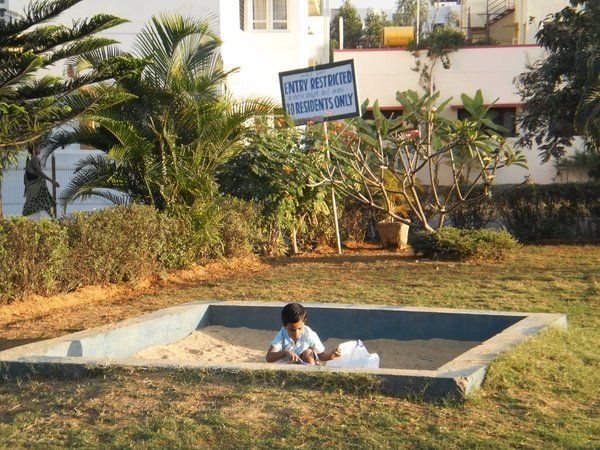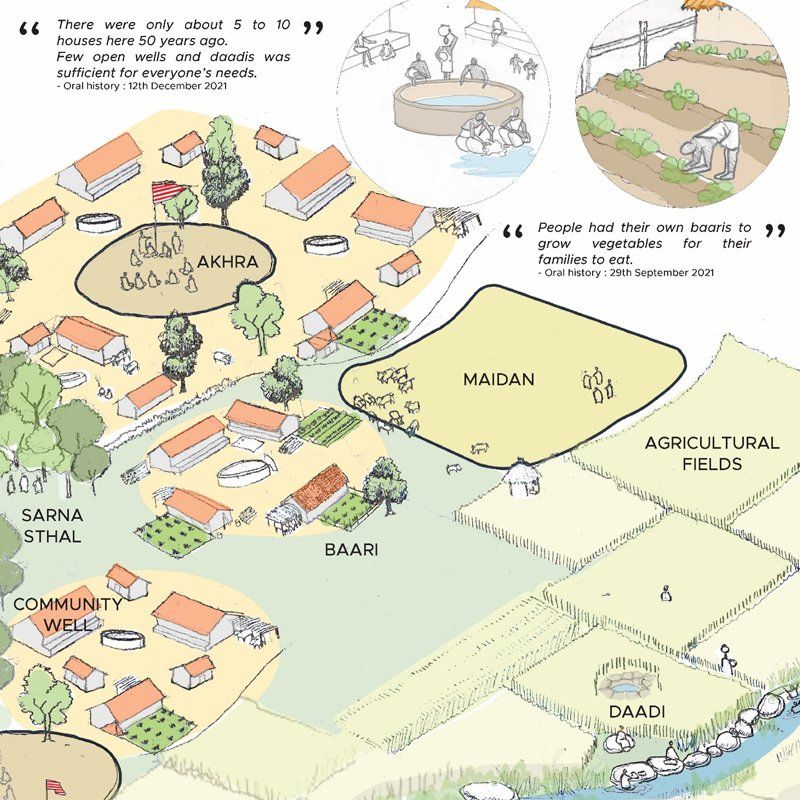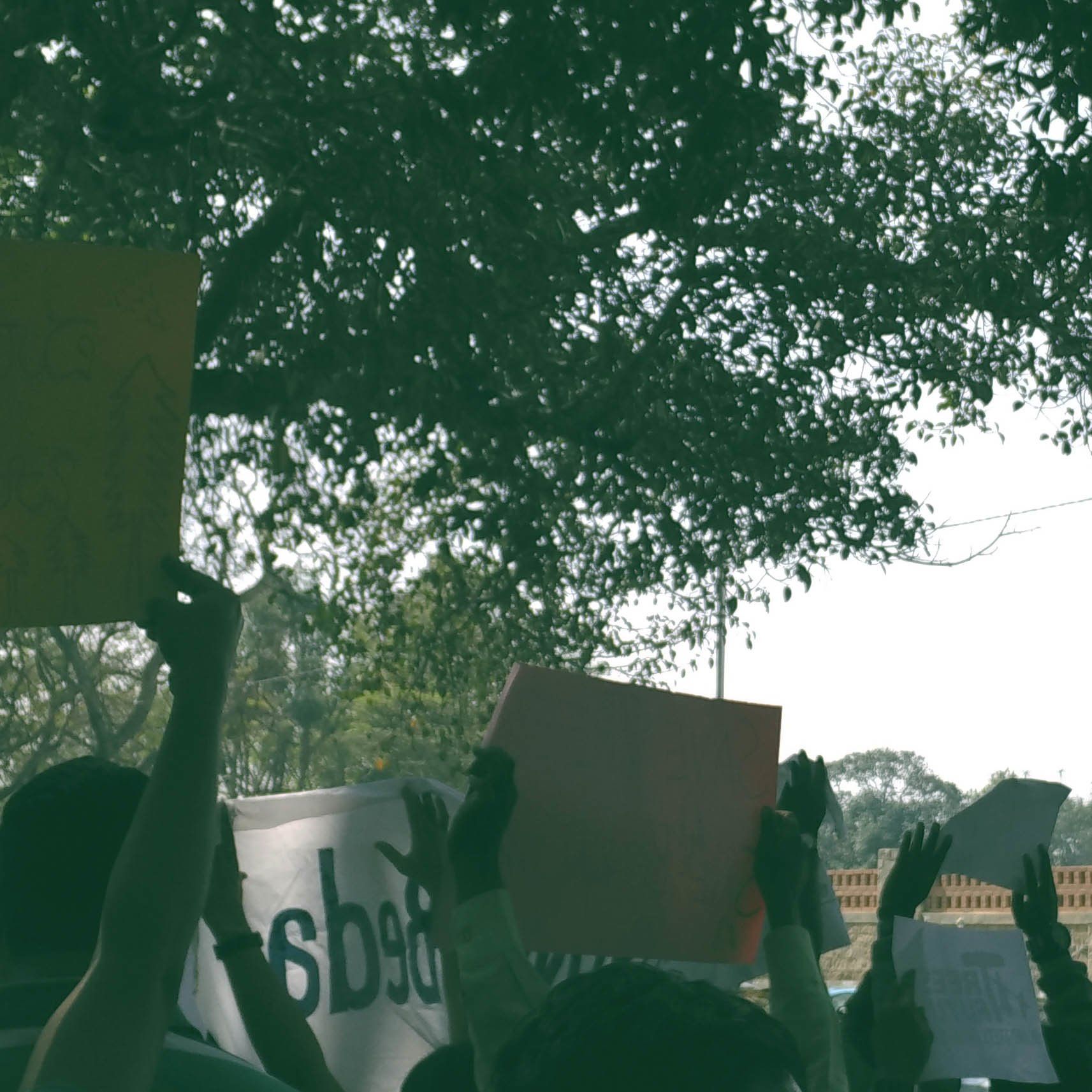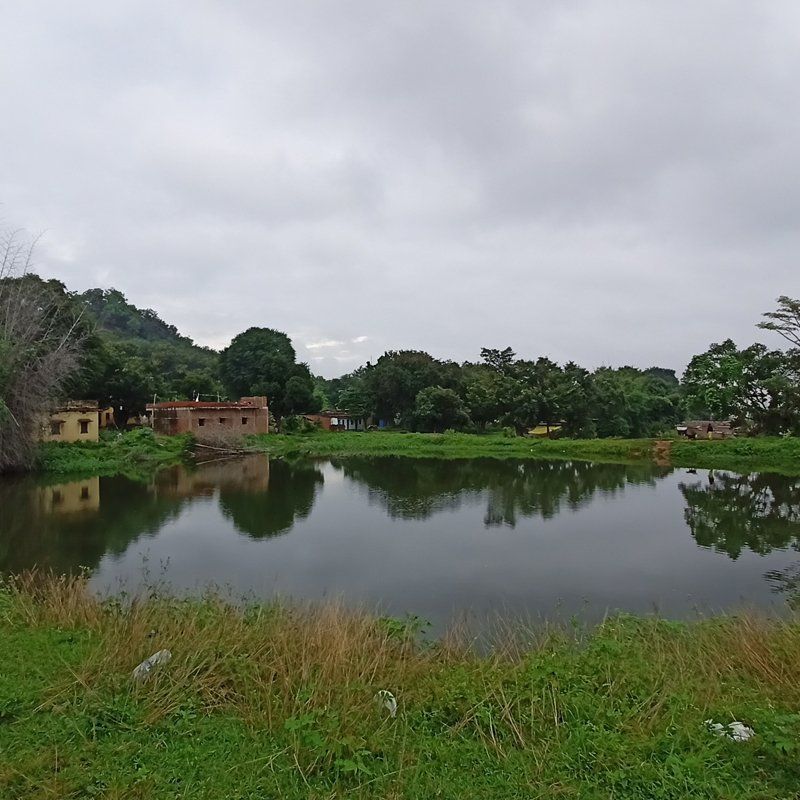Who controls the parks in your layout?
Navya PK for Bengaluru Citizen Matters • January 14, 2011
If you are living in gated community – be it apartments or a layout with independent homes- did you know that your builder would have had to relinquish the parks (you paid for) to get the layout plan sanctioned?

Bengaluru’s townplanning rulebook says apartment complexes with an area more that 20,000 square metres must relinquish parks to public. Likewise layouts – whether ‘gated’ or not – have to relinquish parks to the public too. While some layouts have relinquished albeit reluctantly, some have sued the BDA for it and some are clueless about a rule like this. Authorities on the other hand continue react on a case-to-case basis with no clear-cut policy on implementation.
Some parks in M S Ramaiah city still sport boards restricting public entry. Pic: Navya P K
According to the Comprehensive Development Plan (CDP) 2015, Residential Development Plans (RDP) should relinquish 10% of their land for parks and open spaces, while layouts should relinquish 15% of their area for the same. While some communities allow the public to use the parks with some restrictions, others do not allow public in at all. RDPs are apartment complexes with area greater than 20,000 sq.ms. In Bengaluru’s CDP RDPs are different from layouts.
‘Private’ layouts, public parks?
Take a walk in the parks in M S Ramaiah South City in JP Nagar on an evening. You are likely find very few non-residents using the park. Legally, the park is public as it was relinquished to BDA while obtaining plan sanction for the layout. It is now supposed to be a BBMP park, as BDA handed over the layout to the Palike in 2007.
But among the five parks in the 45-acre layout, some still have boards that say ‘Entry restricted: To residents only’. Mainly the residents use the parks, though there would be couple of outsiders during the evenings. A visitor, who was not a resident of the layout, said, "You can use the park, but it is the residents’ property. If they ask you to leave, you have to go." Another said that he was not sure if he could use the park.
There are no security guards restricting entry, but it is apparent that non-residents are not encouraged to use the park. A resident of the layout says, "It is the residents’ property, but it is your decision as an outsider, you have to think about whether it is right of you to use the park."
KHVR Sagar Holla, General Secretary of the layout’s RWA, says that the boards restricting entry would be removed, and that the residents are accepting of outsiders now. "Earlier many residents were ignorant of the rules. Now we are educating them about this. We do not place any restrictions on public using the park, but after 10 pm those who use the parks and internal roads would be questioned by security guards," he says. There is also fear among residents as incidents of chain snatching and robbery have occurred there recently.
The residents’ reluctance to open the park to public is not just due to security concerns, but also because the park is still maintained by them, with very little help from government agencies. RWA member Eswaraiah says that the residents spend around Rs 50,000 per month for maintaining the parks – this includes gardening, pumping of borewell water for watering lawns etc. Holla says that BBMP’s Horticulture Department had once supplied 400 saplings for planting in the parks, but that there has been no other support.
Unlike MS Ramaiah South City, many layouts and RDPs in the city do not allow public to use their parks at all. For example layouts like Chaithanya Samarpan and Akshaya Red Stone in Kadugodi, adjoining Whitefield, restrict public in parks.
RDPs like Brigade Millennium and L&T South City in Puttenahalli, also place such restrictions. R Rajagopalan, Vice-President of the L&T South City’s apartment owners association SUGRUHA, says that maintenance required would be higher if park is opened to public. "There would be vendors too, especially since the park in complexes like ours and Brigade Millennium’s are located along the internal road marked for public use. In MS Ramaiah South City, the parks are located away from the thoroughfare; many people do not even know about parks inside the layout," he says.
RDPs and layouts are different
Also, in RDPs, the parks are usually the only patch of green in the middle of high-rise apartments. This is unlike Ramaiah City, which has only independent houses in its 300 occupied sites. Also residents in Ramaiah City are required to pay only Rs 325-650 for common area maintenance per month, which is much lesser than what residents of apartment complexes pay.
BDA also appears to give more freedom to RDPs than layouts with respect to park maintenance. E Imbavalli, Technical Assistant (Banglore North), says, "In layouts, parks by default come under the BDA; the RWA can maintain those only if BDA lets them. In layouts like MS Ramaiah North City (Nagwara), HBCS layout and Vyalikaval layout, BDA itself maintains parks, not RWAs. But in RDPs, residents can maintain the park and restrict timings for public use."
BDA Commissioner Bharat Lal Meena says that residents have first rights over parks. But he adds that "Parks are government property and residents cannot stop public from using it. But they can put restrictions to ensure security."
Meena’s statement seems to be only a subjective interpretation of the law. The CDP does not mention anything about the extent of authority residents can have on relinquished property; it only says that residents can maintain these spaces with BDA’s permission.
In some layouts, the park area remains undeveloped as it is ignored after relinquishment. In Amar Jyothi layout in Domlur, three sites were relinquished – one for park and two for civic amenities. All three areas are abandoned or occupied by encroachers. "Neither civic authorities nor residents are enthusiastic about developing these areas," says Prabhakar Alva, former President of layout RWA.
Panduranga nagar layout park is maintained by BBMP and open to public. Pic: Navya P K
In Panduranga Nagar layout off Bannerghatta road, the park area had remained abandoned for over two decades, until the RWA started developing the park two years back with Rs 1 lakh. They also appointed a staff to maintain the park. Due to fund constraints, they sought support from a BBMP Corporator.
"After this, the BBMP started developing the park. Almost 75% of the work is complete now. BBMP has appointed its own staff for maintenance; so we have no control over the park at all, but we do not mind, as it is developed," says Parameshwar Bhat, Secretary of the layout’s RWA.
No coherent view within BDA
If parks are going to be have to be relinquished anyway, who should be developing them? The private developer of the layout (builder) or the BDA, which sanctions the RDPs an and layouts? Even within the BDA, there isn’t coherent view on the law.
BDA’s Technical Assistants and Commissioner Meena also have different interpretations of the CDP, regarding whether parks should be developed with residents’ money. Imbavalli says that builders of layouts/RDPs only have to relinquish the area marked for parks and not necessarily develop them, to get plan sanction. But Meena, and BDA Town Planning Member S S Topgi, say that builders have to plant trees and fence the area.
Meena says, "When the builder develops the entire area, how can they leave out only the park area? If not them, who will spend the money for that?" he asks.
Rajesh, PRO at Chaithanya Builders, says, "BDA does not develop the park area after relinquishment. So eventually we develop it and hand it over to residents. Residents have no ownership; they only have the rights to use it."
Buyers of homes or plots, who bear the cost of building and maintaining the park too, are often not aware of relinquishment. Later and not surprisingly, they resist opening up parks to public. Meena does not address this concern. The only reason some of such layouts appear to let the public use their parks is that the law demands it.
In the case of L&T South City though, the apartment owners are contesting the ownership of the park itself, as the relinquishment was not mentioned in the sale documents.
Real estate agent Santosh Bhurani says that relinquishment has not yet emerged as an issue. "Builders keep quiet about relinquishment as the rule is still on paper only. BDA does not insist on letting public use parks either. In layouts BDA might interfere, but in RDPs it is assumed to be private property," he says.
Sudarshan, Technical Assistant (Bangalore South) in BDA confirms this. He says that the rules are not insisted on as BDA got the land from residents in the first place. "We have not got any complaints from public about not being able to use parks. If you want to use the park you can, who is stopping you?"
Raghavendra Rao, President of Chaithanya Samparpan Owners Welfare Association (CSOWA), says that the residents would be willing to pay higher taxes to retain the parks for themselves rather than open it to public.
Does relinquishment help?
Architect and consultant Mohan Rao says that it is BMRDA’s (Bangalore Metropolitan Region Development Authority) responsibility to develop a plan for integrating parks. Rao runs an a design firm called InDe from Jayanagar. His latest work includes planning for the city of Surat.
"BDA gives sanction by looking at the numbers only; the vision should be BMRDA’s. Many ‘gated communities’ are 4-5 acres of land and the parks here are small patches compared to the city’s landscape. Relinquishing them does not serve any purpose; such spaces should be integrated to form a larger green space for the public."
Layouts are not islands, they should be developed by considering the realities in the neighbouring areas, says Rao

Being a member of the Adaptation Research Alliance, ARA (a global, collaborative effort to increase investment and opportunities for action research to develop/inform effective adaptation solutions) and an ARA Micro grantee, Integrated Design (INDÈ) was invited to organise a networking session at the Global Gobeshona Conference-2 (conference theme: exploring locally led adaptation and resilience for COP27). The networking session was titled ‘Situating Urban (City) Resilience within the City-Region’ and was held on 1 April 2022.

The online magazine SustainabilityNext carried an article by Benedict Paramanand titled “Has Fatigue Set into Civic Activism in Bengaluru?” The article caught my eye amidst the Covid 19 humdrum as I was looking for alternative news. I have been actively engaged in the debates around the (ill)growth and mis(management) of Bangalore for over two and half decades in my capacity as a professional planner straddling civic society, public policy circles and academia. The article revived in my mind some thoughts and suggestions that I articulate here. The attempt is not so much to answer the question, as it is to understand the shortcomings and limitations of civic activism in steering the complex politico-socio-economic and cultural layers that make up a vast conglomeration like Bengaluru. A disclaimer here merits mention. The premise that no individual stakeholder, public or private, has the knowledge and resources to tackle the wicked problems underpins successful governance arrangements. What this premise implies, by extension is that all stakeholders – public or private – have limitations. Civic Society (CS) is one amongst the numerous stakeholders that have a role – by no means a lesser one- to play. Yet, there are limitations to this role. While these limitations are embedded in the very nature of operation of the CS, there are conscious ways and means of overriding some limitations to move towards a larger impact. Bridging limitations is a critical need. Much of what I articulate while contextual to Bengaluru, perhaps holds true for civic activism across domains and geographies. To begin with, a critical question requiring reflection is the difference between civic activism and the much advocated (in (good) governance debates) Civic Society Organisation (CSO) engagement. These generally get clubbed in one category – while in theory and practice, that is not the case and therein lies the first limitation. Activism defined as direct vigorous action especially in support of or, in opposition to, one side of a controversial issue is willy-nilly an act of reaction. Reaction often leaves little space for taking distance and exploring the systemic cause of the challenge – the challenge itself sets the agenda. In contrast a proactive engagement of the civic society, through progressive partnerships while also triggered by a challenge is different in that the challenge is anticipated and therefore the agenda is set by civic society themselves. In Bengaluru, protests against the state-imposed flyover (# steelflyoverbeda ) and elevated corridors (# TenderRadduMadi ) is an example of the former. In contrast, the long-standing work on the ward committees which has seen some traction in the recent past – albeit slow and tardy – is an example of the latter. Having started as a proactive CSO engagement, the movement for neighbourhood planning and governance through ward committees (# NammaSamitiNamagaagi ) in the recent past has bordered on being reactionary, thereby hinging on activism. Although an ‘always proactive approach’ is not possible, given the capacity of our government to spring surprises, it is critical that the CS begins to move towards a proactive stance. There will always be a non-uniform interplay between being reactive and proactive. A second limitation, linked to the first, is the lack of capacity of the CS to act on relevant and practical evidence. This will require the CS to open their doors and develop progressive partnerships, including partnerships with policy makers, professionals (note that I do not use the word experts) and academia. An all-time reactionary mode of operation allows neither for collaborations nor evidence. Evidenced advocacy and conversations require domain knowledge (experienced domain knowledge is even better) which can facilitate knowledge production and mobilization. Activism hinges on passion (amongst other drivers) which is not the same as domain knowledge and knowledge mobilization. Both passion and domain knowledge have a role, yet the two can neither replace each other nor should be confused. Rather, passion that pivots on evidence and knowledge is a double-edged sword, one that has the capability to steer reactionary behavior to an informed proactive engagement. Such a move will serve to, over a period of time, course correct policies that are currently influenced by dominant political structures, electoral volatility and elite capture, as against being evidence based. A third limitation that needs consideration is the nature, purpose, goal and objective of the civic society coalition/group. Most often mobilisation is around a seemingly common purpose, goal and objective. For instance, groups that coalesced against large infrastructure projects as mentioned above or the demand for footpaths and public transit (# BusBhagyaBeku ) and sub-urban rail (# chukuBukuBeku ) are not homogeneous. It is often a mixed bag as against an imagined and perhaps desired integrated unit. Underpinning this pursuit of collective goals and objectives are individual desires, identities (which in themselves are multiple), beliefs, perspectives and previous experience, all of which are critical drivers, often leading to fragmented voices. This fragmentation notably, also derives from the inability to use evidence or domain knowledge. Elitist Activism Furthermore, activism in itself is and can be elitist. When linked to high levels of access it can be potentially hampered by what is referred to as ‘elite capture’. There are two types of activism: elite activism stemming from mobilization of charismatic individuals capable of getting their voice heard. Mass activism, in contrast, is where the general public, the haves and the have-nots, mobilize collectively. The two are not mutually exclusive, although both are critical. Barring a few occasions, Bengaluru’s activism has been elitist with a few voices that can access public policy corridors and therefore get heard. Consequently, consciously or unconsciously there is a leveraging of public policy for personal or limited gains (to a neighbourhood or a community). Activism is a luxury that not everyone can afford. Those who can afford it have a dual responsibility of using it to build bridges by roping in knowledge and experience on one hand and ensuring inclusion by creating spaces and opportunities for mass activism, on the other. The current modus operandi lacks on both counts. These shortcomings have led to what is being referred to as limited success, although limited from whose lens and success for whom is an additional enquiry, one that merits a separate post. What I do concur with is that at best the city has seen some cosmetic changes. Let me take the same two examples the article uses to demonstrate a going forward beyond cosmetic progress. First are the lakes in Bangalore that have seen a fair bit of activism. In many neighborhoods, thanks to the many charismatic residents, lakes have been claimed as better maintained natural resources. But for the initiatives of a few citizens, many lakes would have morphed into real estate projects. Yet, the same groups have done little to engage the larger neighborhoods to ensure that these natural resource ‘spaces’ become public ‘places’ for the neighborhood and the city. This would require a proactive engagement in identifying the larger neighborhood and the numerous linkages – backward and forward – that this neighborhood has had and can nurture with the lakes as public places. The second is the Tender Sure roads pioneered by Bengaluru. The implementation of Tender Sure roads is progressing incrementally moving from a pilot in the city core to radiating outwards in various directions. Putting aside the debates on the efficacy of the design as well as the appropriateness and relevance of the idea, the incremental implementation is marked by controversies on the criteria to shortlist roads such that both the visibility of and utility to the neighborhood and the city can be maximized. This too has not happened. Both these examples offer a critical insight: that the activism (and the few instances of engagement) has not translated into a thinking city. Changes are still hovering around the thinking individual. The transition to a thinking city is an emerging imperative, one that demands systemic change along various dimensions, some of which I have discussed above. To sum-up, sustained and big bang change as against cosmetic and incremental change is the need of the hour. It requires at the outset, one, more proactive engagement and less reactive activism; two, passion combined with experienced domain knowledge to trigger evidenced advocacy and change; and, three a less fragmented approach through creating meaningful spaces for mass activism along with the existing elite activism that the city has. While there may be numerous ways to act on these three, the Ward Committee space offer a ready platform for proactive action, evidence-based advocacy and wider participation. Arguably, this space is rife with political contestations and may seem a daunting challenge, yet, an engagement within this space is a surer foot forward. Clearly, there is a passion amongst Bangalore’s elite to be part of something bigger and this is a moment to be seized.


